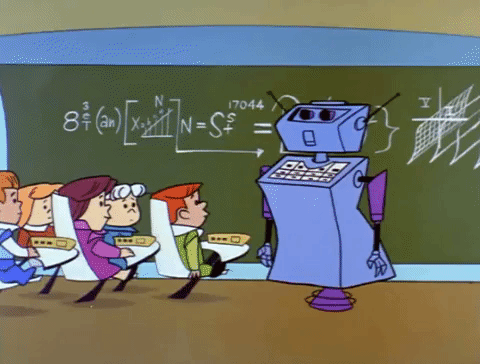What’s the first thing that comes to mind when you envision the classrooms of the future? 🔮

![]()
Of course, sci-fi depictions of robo-teachers like the one from The Jetsons above are endearing, but we’re not here today to talk about science fiction – rather, today’s blog is taking a closer look at a handpicked selection of pioneering classrooms that are paving the way for the future of K12 education.
Say hello to the project-based, student-focused, and technology-driven classrooms of tomorrow:
Filmmaking 101
Familiar with social media platforms like Facebook, Twitter, and Instagram? Of course you are – and you’ve probably noticed that all of these platforms have placed increased emphasis on hosting and showcasing video content in recent years. And that’s not even considering the popularity of dedicated video streaming platforms like Netflix and YouTube, the latter of which boasts itself as the second most popular search engine in the world (bested only by Google, of course). Clearly, video content is in high demand at the moment – and the U.S. Bureau of Labor Statistics echoes this, predicting a faster than average job outlook of 13% for film/video editors and camera operators over period of 2016-2026.
Perhaps integrating introductory video production lessons into the classroom might be a good idea, right?
This thinking ultimately inspired California educator Jim Sill to begin offering a series of media production classes at his high school, aimed at teaching students key filmmaking skills like shooting, editing, writing, and more. Check out his full story:
Want to learn how you can help unleash student creativity through the power of video? EdSurge has got you covered!
Robots in the Classroom
While we’re wholly against the idea that robots will one day replace real-life teachers, we do believe that robots deserve a role in the classrooms of the future!
There exist an endless number of benefits of implementing robotics into K12 classrooms, both expected and unexpected. Robotics lessons and after-school clubs serve as a great hands-on way to help young learners practice and develop key 21st century skills like communication, critical thinking, and creativity as they connect abstract STEM concepts to real-life learning outcomes. Check out how these classrooms are teaching key STEM concepts using LEGO’s popular MINDSTORMS EDUCATION EV3 robotics kits:
It’s true: integrating robotics into K12 curriculum can help students foster essential skills like collaboration, problem solving and project management – learn more about the benefits of student robotics in this article from Edutopia!
Exploring New Realities with AR/VR
It’s no secret that our studio loves to talk about augmented and virtual reality for learning.
Let’s get one thing straight right off the bat – educational AR/VR experiences are not designed to replace any aspect of a traditional classroom experience. While we’re certain that technologies like VR can enhance learning, it’s unlikely that textbooks and classrooms – let alone real-life teachers – will be going away anytime soon (if ever!) However, what these new immersive technologies can offer students are unforgettable learning experiences that often would be simply unattainable without AR or VR.
Check out how the classroom below is using virtual reality as a tool for enhancing student engagement, bridging the gap between abstract lessons and hands-on learning:
Ready to take the leap into a new (virtual) reality? Check out ISTE’s roundup of 25 resources for bringing AR and VR to the classroom!
Hands-on robotics challenges, video production courses, and immersive AR/VR lessons – each of these innovative learning technologies are inherently fascinating. But what’s lies the true value of these cross-curricular learning experiences?
Simply put: these classrooms are empowering students by allowing them to get hands-on with the types of tools and technologies that will prove vital to their success in the future – whether in later schooling, their desired career path, or simply as a member of their communities. According to a report from The World Economic Forum titled The Future of Jobs, 65 percent of students entering grade school today will someday end up performing jobs that don’t even exist yet – making it vital for educators to do everything in their power to help prepare their students of today for the jobs of tomorrow (and beyond!)
Of course, it’s impossible to expect teachers and administrators to predict what the future will look like for today’s students. While tools like robotics kits, video production equipment, and virtual reality headsets are awesome, it’s ultimately not about the technologies themselves that matter – rather, these technologies serve as a conduit, helping to both enhance engagement in the classroom today and give students the hands-on learning experiences they’ll need to succeed in their future careers. While we can’t foresee the future, what we can do right now is teach students core competencies like adaptability, collaboration, open-mindedness – real-life, applicable skills that will serve as assets as students move beyond school and transition into various new job disciplines and roles.